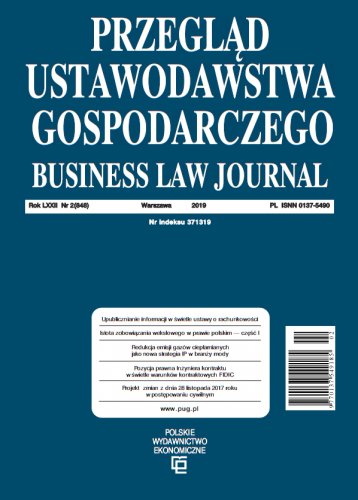Legal situation of underground routes and underground tourist facilities
The interior of the earth's crust is sometimes used for tourism, recreational, therapeutical and even sports, entertainment or other purposes. Example includes closed excavations of underground mining plants, caves and other similar objects, especially of a military nature. Their legal situation is extremely varied and full of doubts. Most of the requirements of the Geological and Mining Act apply, mutatis mutandis, to the use (for the purposes described above) of underground excavations workings of liquidated mining plants. The space within which the said objects are located is not covered by land ownership; it is the subject of a mining property right vested in the State Treasury. There are no grounds to apply these solutions to other underground facilities. In most cases, they are located within the spatial boundaries of land properties. An additional difficulty is the fact that it is extremely difficult to establish the criteria separating the space covered by the boundaries of land properties from those constituting the subject of mining property. Both of the above-mentioned categories of underground objects may qualify for monument protection, but they do not always fill into the division of monuments into "movable" and "immovable" (real property) objects. Therefore, it is doubtful whether they can be protected as monuments at all.
References
Bibliografia/References
Literatura/Literature
Ciurlok, J. (2018). Warto pamiętać o świadectwach górniczej historii. Morskie opowieści na Górnym Śląsku? Biuletyn Górniczy, (7–9).
Dobosz, P. (2012). Nieruchomość zabytkowa jako przedmiot regulacji prawnej. W: I. Niżnik-Dobosz (Red.), Przestrzeń i nieruchomości jako przedmiot prawa administracyjnego. Publiczne prawo rzeczowe. LexisNexis.
Dobrowolski, G., Lipiński, A., Mikosz, R., & Radecki, G. (2018). Gospodarowanie geologicznymi zasobami środowiska w świetle zasady zrównoważonego rozwoju. Zagadnienia prawne. Wydawnictwo Uniwersytetu Śląskiego.
Ginter, A., & Michalak, A. (2016). Ustawa o ochronie zabytków i opiece nad zabytkami. Komentarz. Wolters Kluwer.
Golat, R. (2004). Ustawa o ochronie zabytków i opiece nad zabytkami. Komentarz. Zakamycze.
Jedynak, A. (2008). Prehistoryczne kopalnie krzemienia pasiastego i podziemna trasa turystyczna „Krzemionki”. Kopaliny, (3).
Lipiński, A. (2016). Komentarz do art. 1–2 ustawy z dnia 9 czerwca 2011 r. – Prawo geologiczne i górnicze (Dz.U. 2015, poz. 196 ze zm.). Prawne Problemy Górnictwa i Ochrony Środowiska, (1).
Lipiński, A. (2019). Prawne podstawy geologii i górnictwa. Wolters Kluwer.
Łopatecki, K. (2007). „Obiekt o cechach zabytku” a „zabytek” – problemy terminologiczne w świetle ustawy o ochronie zabytków i opiece nad zabytkami. Zeszyty Dziedzictwa Kulturowego, 1.
PTTK Oddziała Ziemi Tarnogórskiej, Tarnogórski Klub Taternictwa Jaskiniowego. (2013). Podziemia Tarnogórskie – żywy organizm na
wybranym fragmencie Kopalni Fryderyk (Blachówka Zachodni–Urban–Glückhilfe). http://tktj.pl/wp-content/uploads/2020/11/Podziemia-Tarnogorskie-%E2%80%93-zywy-organizm-skompresowany.pdf
Rakoczy, B. (2015). Komentarz do art. 2. W: B. Rakoczy (Red.), Prawo geologiczne i górnicze. Komentarz. Lex.
Roszkiewicz, J. (2011). Przewodnik po Polsce. Podziemne trasy turystyczne. Daunpol.
Rzeczycki, T. (2016). Historyczne rozmaitości nie tylko węglem pisane. Szychta w Jaskini Niedźwiedziej. Biuletyn Górniczy, (9–10).
Rzeczycki, T. (2020). Warto pamiętać o świadectwach górniczej historii. Kopalnia Amalia w Srebrnej Górze. Biuletyn Górniczy, (10–12).
Sabaciński, M. (2007). Relikty pradziejowego górnictwa w rejonie Gór Świętokrzyskich w kontekście eksploatacji złóż krzemienia pasiastego. Problematyka prawno-konserwatorska. Zeszyty Dziedzictwa Kulturowego, 1.
Schwarz, H. (2013). Prawo geologiczne i górnicze. Komentarz. Tom I. Salome.
Skorupka, S., Auderska, H., & Łempicka Z. (Red.) (1969). Mały słownik języka polskiego. PWN.
Sługocki, J. (2017). Opieka nad zabytkiem nieruchomym. Problemy administracyjnoprawne. Wolters Kluwer.
Zalasińska, K. (2020). Ustawa o ochronie zabytków i opiece nad zabytkami. Komentarz. C.H.Beck.
Zeidler, K. (2007). Prawo ochrony dziedzictwa kultury. Oficyna. A Wolters Kluwer business.
Orzecznictwo/Judgments
Wyrok NSA z 4.11.2004 r., OSK 1151/04.

